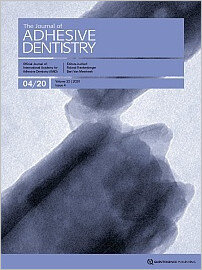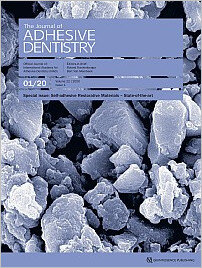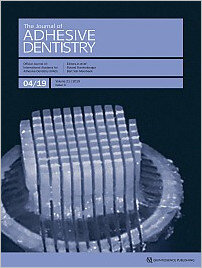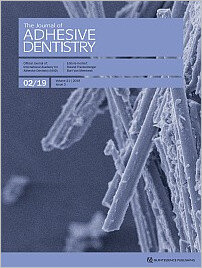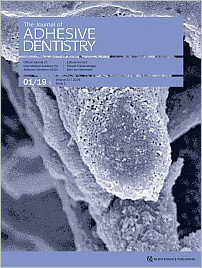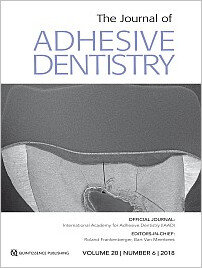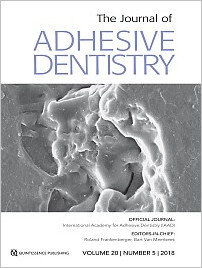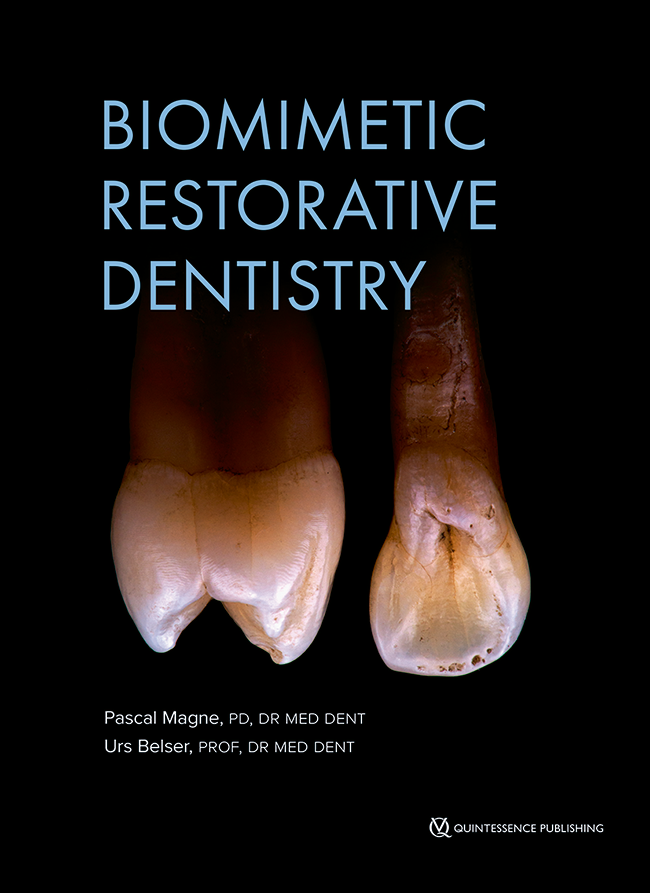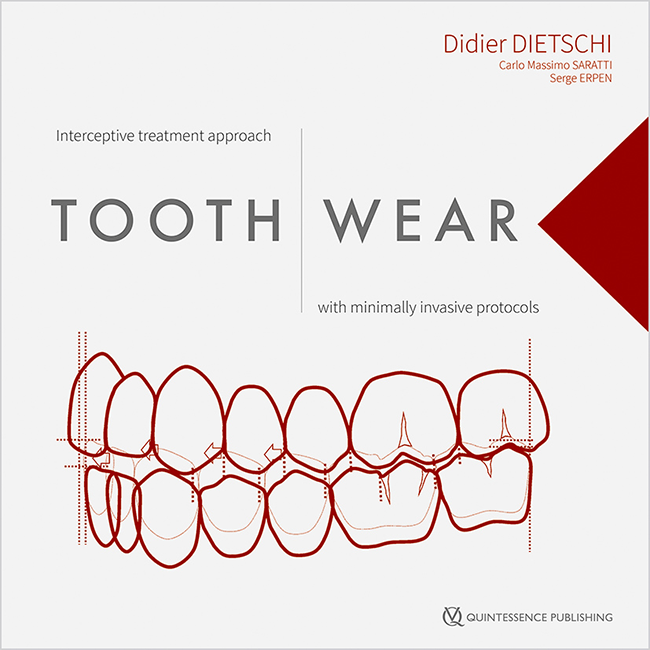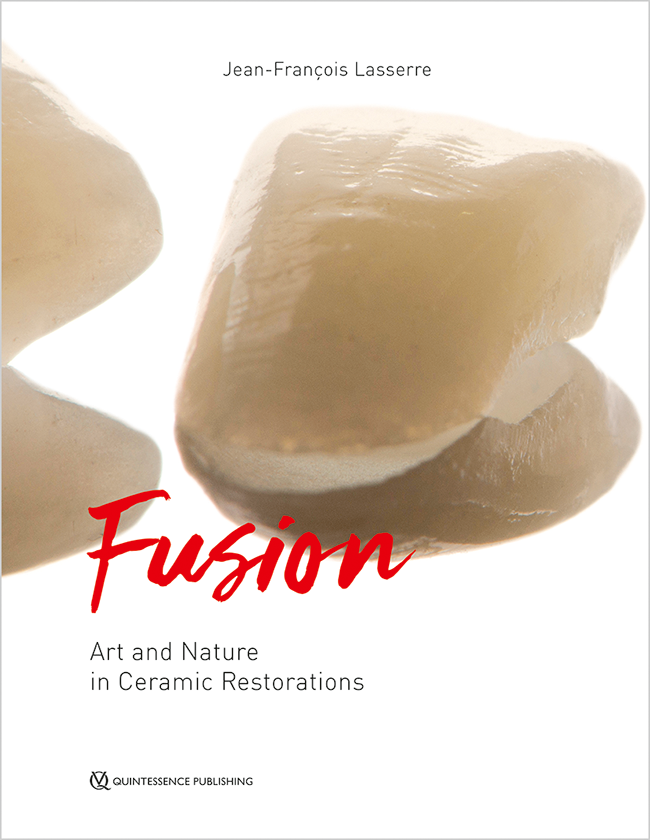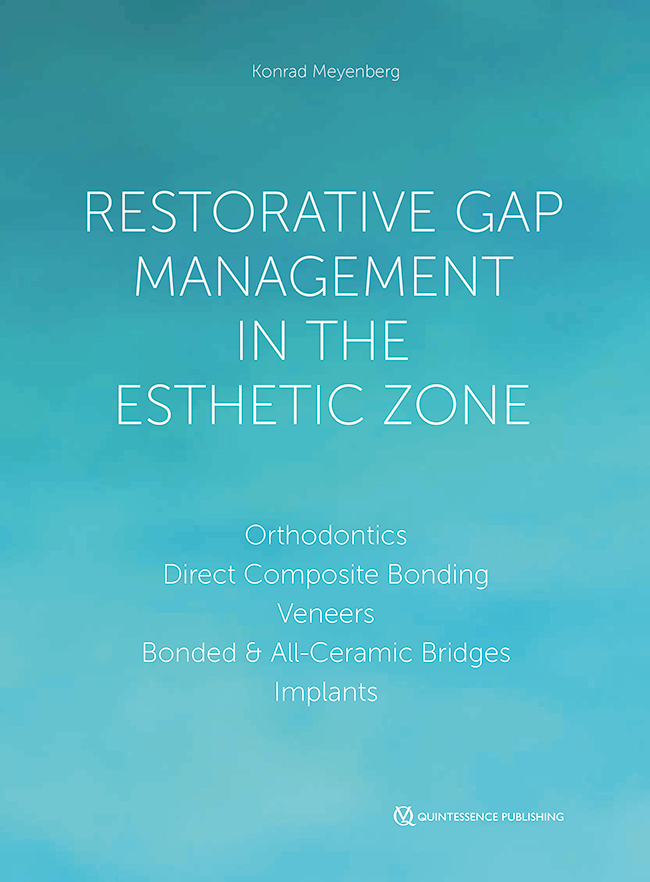DOI: 10.3290/j.jad.a44922, ID de PubMed (PMID): 32666059Páginas 339, Idioma: InglésVan Meerbeek, Bart / Frankenberger, RolandDOI: 10.3290/j.jad.a44865, ID de PubMed (PMID): 32666060Páginas 343-351, Idioma: InglésCerutti, Antonio / Barabanti, Nicola / Özcan, MutluPurpose: This randomized, split-mouth clinical study evaluated the marginal quality of direct class-I and class-II restorations made of microhybrid composite that were applied using two polymerization protocols and two marginal evaluation criteria.
Materials and Methods: A total of 50 patients (mean age: 33 years) received 100 direct class-I or class-II restorations in premolars or molars. Three calibrated operators made the restorations. After conditioning the tooth with 2-step etch-and-rinse adhesive, restorations were made incrementally using microhybrid composite. Each layer was polymerized using a polymerization device operated either in regular mode (600-650 mW/cm2 for 20 s) (RM) or high-power (1200-1300 mW/cm2 for 10 s) mode (HPM). Two independent, calibrated operators evaluated the restorations 1 week (baseline) and 6 months after restoration placement, and thereafter annually up to 10 years using modified USPHS and SQUACE criteria. Data were analyzed using the Mann-Whitney U-test (α = 0.05).
Results: Alpha scores (USPHS) for marginal adaptation (76% and 74% for RM and HPM, respectively) and marginal discoloration (70% and 72%, for RM and HPM, respectively) did not show significant differences between the two polymerization protocols (p > 0.05). Alpha scores (SQUACE) for marginal adaptation (78% and 74% for RM and HPM, respectively) and marginal discoloration (70% for both RM and HPM) were also not significantly different at the 10-year year follow-up (p > 0.05).
Conclusion: Regular and high-power polymerization protocols had no influence on the stability of marginal quality of the microhybrid composite tested up to 10 years. Both modified USPHS and SQUACE criteria confirmed that regardless of the polymerization mode, marginal quality of the restorations deteriorated significantly compared to baseline (p 0.05).
Palabras clave: photopolymerization, resin composite, USPHS, SQUACE
DOI: 10.3290/j.jad.a44866, ID de PubMed (PMID): 32666061Páginas 353-363, Idioma: InglésChidoski-Filho, Julio Cezar / Camargo, Lucas Pagano / Bittencourt, Bruna Fortes / Reis, Alessandra / Gomes, Osnara Maria Mongruel / Gomes, João Carlos / Gomes, Giovana MongruelPurpose: To evaluate the influence of type and viscosity of composite resins used for root reinforcement in the adhesion of glass-fiber posts to flared root canals.
Materials and Methods: The crowns of 78 uniradicular permanent teeth were removed and the teeth were endodontically treated. After one week, the roots were prepared for root reinforcement and randomly divided into 6 groups (n = 13): positive control group ([PCG] the root canals were not enlarged), negative control group ([NCG] root canals were enlarged, no reinforcement), and in the remaining 4 groups, root canals were enlarged to receive root reinforcement according to a combination of the factors composite resin type (bulk-fill or conventional) and viscosity (flowable or regular). After fiber post cementation, six slices were obtained from each root (2 each from the cervical, middle, and apical thirds). For each group, 7 teeth underwent push-out bond strength testing, and 6 teeth were evaluated for nanoleakage and Vickers microhardness. Bond strength and nanoleakage data were submitted to two-way ANOVA and Tukey's test (α = 0.05), and microhardness data to one-way ANOVA and Tukey's test (α = 0.05).
Results: The root reinforcement groups with regular and flowable bulk-fill composite resins showed statistically superior adhesion results (higher bond strength and less nanoleakage) compared to the negative control in all root regions. Microhardness values were higher in the cervical third followed by the middle third.
Conclusion: Regular or flowable bulk-fill composite resins should be chosen for root reinforcement of flared root canals prior to fiber post cementation.
Palabras clave: composite cements, fiber post, root canal, shear strength, hardness test
DOI: 10.3290/j.jad.a44867, ID de PubMed (PMID): 32666062Páginas 365-372, Idioma: InglésDieckmann, Phoebe / Baur, Anina / Dalvai, Vanessa / Wiedemeier, Daniel B. / Attin, Thomas / Tauböck, Tobias T.Purpose: To investigate the reparability of aged and fresh resin composite after different mechanical surface pretreatments.
Materials and Methods: Sixty composite specimens (Filtek Supreme XTE, 3M Oral Care) were either aged by thermal cycling (5000 cycles, 5–55°C) and six months of water storage, or immediately processed within 5 min after polymerization. Both aged and fresh specimens were either ground with fine (46-µm) or coarse (100-µm) diamond burs and then silanized or sandblasted with aluminum oxide (Al2O3) and silanized. In the negative control group, no mechanical surface pretreatment or silanization was performed. Specimens (n = 6 per group) were repaired with an adhesive (OptiBond FL, Kerr) and a resin composite (Filtek Supreme XTE). Directly adhered composite-to-composite increments served as the positive control group. After thermoycling, microtensile repair bond strength was assessed and statistically analyzed (α = 0.05).
Results: Aged composite surfaces revealed significantly lower repair bond strength than immediately repaired composite. The negative control group demonstrated the significantly lowest microtensile bond strength of all groups. No significant differences in repair bond strength were observed between the different mechanical pretreatments for both aged and fresh specimens. The repair bond strength of fresh composite pretreated with a fine diamond bur + Al2O3 + silane or a coarse diamond bur with/without Al2O3 + silane did not differ significantly from the positive control group.
Conclusion: The age of the repaired composite has a greater influence on repair bond strength than does the type of composite surface pretreatment.
Palabras clave: composite repair, aged composite, immediate reparability, surface pretreatment, aluminum oxide sandblasting, microtensile bond strength
DOI: 10.3290/j.jad.a44868, ID de PubMed (PMID): 32666063Páginas 373-382, Idioma: InglésChen, Bingzhuo / Yan, Yue / Xie, Haifeng / Meng, Hongliang / Zhang, Huaiqin / Chen, ChenPurpose: To determine and compare the effects of tribochemical silica coating and alumina-particle air abrasion on 3 mol% and 5 mol% yttria-stabilized tetragonal zirconia polycrystals (Y-TZP).
Materials and Methods: Two different 3Y-TZP samples (Lava Plus, 3M Oral Care; Ceramill Zolid, Amann Girrbach) and one 5Y-TZP sample (Katana Zirconia UTML, Kuraray Noritake) were prepared and treated with alumina-particle air abrasion and a 10-methacryloyloxydecyl dihydrogen phosphate (10-MDP)-containing self-adhesive composite cement or with tribochemical silica coating followed by silanization (n = 30). Resin columns were cemented onto the treated ceramic surfaces to form specimens. After 24-h water storage or aging with 10,000 thermocycles plus 60-day water storage, shear bond strength (SBS) testing was conducted. Surface roughness, surface Vickers hardness, and crystallographic phase analyses were also performed.
Results: The SBS of tribochemically silica-coated 5Y-TZP before and after aging were 13.8 ± 1.4 and 13.2 ± 1.5 MPa, resp., for Lava Plus (3Y-TZP) 14.4 ± 1.4 and 13.9 ± 1.6 MPa, respectively, and for Ceramill Zolid (3Y-TZP) 14.8 ± 1.1 and 13.9 ± 1.5 MPa, respectively. There was no statistical difference between tribochemical silica coating and alumina air abrasion treatments (p = 0.21) on the bonding performance (SBS) of the 3Y-TZPs and 5Y-TZP (p = 0.25) before and after aging (p = 0.50). After alumina air abrasion, 5Y-TZP showed higher surface roughness (Ra = 1.7 ± 0.1) than did the 3Y-TZPs (Ra = 1.2 ± 0.1 for Lava Plus; Ra = 1.2 ± 0.1 for Ceramill Zolid), while the Vickers hardness was similar among the three materials (p = 0.70). Monoclinic zirconia was not detected in 5Y-TZP irrespective of treatment, with the zirconia being mainly cubic phase. However, the 3Y-TZPs were mainly tetragonal phase with some monoclinic zirconia; the latter increased after being alumina-particle air abraded.
Conclusion: The bond strength to 5Y-TZP is similar to those of the 3Y-TZPs under the same bonding strategies. Durable bonding can be achieved both by alumina air abrasion combined with a 10-MDP-containing self-adhesive composite cement and by tribochemical silica coating followed by silanization for both the 3Y-TZPs and 5Y-TZP.
Palabras clave: zirconia, Y-TZP, shear bond strength, air abrasion, tribochemical silica coating, aging
DOI: 10.3290/j.jad.a44869, ID de PubMed (PMID): 32666064Páginas 383-391, Idioma: InglésAl-Dobaei, Eglal / Al-Akhali, Majed / Polonskyi, Oleksandr / Strunskus, Thomas / Wille, Sebastian / Kern, MatthiasPurpose: To evaluate the influence of different cleaning methods on the resin bond strength to contaminated translucent 3Y-TZP ceramic.
Materials and Methods: A total of 133 airborne-particle abraded (0.1 MPa) zirconia specimens were divided into 7 groups. Uncontaminated zirconia specimens were either not cleaned (UN) or cleaned with cleaning paste (Ivoclean) (UP1). After contamination by saliva and blood immersion, zirconia specimens were cleaned using either distilled water rinsing (CW), 99% isopropanol in an ultrasonic bath (CI), cleaning paste according to manufacturer's instructions (CP1), cleaning paste with additional rubbing (CP2), or additional airborne-particle abrasion at 0.1 MPa (CA). Three specimens from each group were examined by x-ray photoelectron spectroscopy (XPS). For each group, sixteen Plexiglas tubes filled with composite resin (Clearfil FII, Kuraray Noritake) were bonded to the zirconia specimens using a primer (Clearfil Ceramic Primer Plus, Kuraray Noritake) and luting composite (Panavia V5, Kuraray Noritake). Before measuring tensile bond strength, specimens were stored in distilled water for 3 or 150 days plus 37,500 thermal cycles.
Results: After 3 days, no group showed significantly different TBS compared to the control group UN (p > 0.05). However, groups CW and CI showed significantly lower TBS than all other groups after 150 days (p ≤ 0.05). XPS analysis revealed more organic residue on zirconia surfaces of groups CW and CI than on the other groups.
Conclusion: Cleaning with the cleaning paste and airborne-particle abrasion were effective in removing saliva and blood contamination and enhancing bond strength.
Palabras clave: contamination, cleaning methods, cleaning paste, bond strength, translucent 3Y-TZP ceramic
DOI: 10.3290/j.jad.a44870, ID de PubMed (PMID): 32666065Páginas 393-398, Idioma: InglésGuarda, Maurício Bottene / Di Nizo, Paolo Tulio / Abuna, Gabriel Flores / Catelan, Anderson / Sinhoreti, Mário Alexandre Coelho / Vitti, Rafael PinoPurpose: To assess the effect of the application of different electric currents on dentin bonding and resin infiltration of self-etching and etch-and-rinse adhesives.
Materials and Methods: Two hundred four sound third molars were selected and divided in groups according to the adhesive (self-etch [CSE, Clearfil SE Bond, Kuraray Noritake], universal [SBU, Single Bond Universal, 3M Oral Care], and etch-and-rinse [SB2, Adper Single Bond 2 (SB2), 3M Oral Care]) and electrical current used (0, 5, 10, 15, 20, 25, 30, and 35 μA). Light curing was performed for 10 s with an LED-curing unit at 1000 mW/cm2. Composite blocks were constructed of nanofilled composite in increments of 2 mm, which were light cured for 20 s. Specimens were sectioned into sticks with a cross-sectional area of ~1 mm2 and stored in distilled water at 37°C for 24 h. Microtensile bond strength (μTBS) testing (n = 8) was performed using a universal testing machine at a crosshead speed of 0.5 mm/min until failure. The bonding quality (n = 2) of adhesives applied with or without 35-μA electric current was evaluated using confocal laser scanning microscopy. Bond strengths were analyzed with two-way ANOVA and Tukey's test (α = 0.05).
Results: CSE presented the highest μTBS for all electrical currents tested. For CSE and SBU, electrical currents from 0-20 μA showed the lowest μTBS. Electrical currents from 0-10 and 20-25 μA yielded the lowest μTBS for SB2. CSE and SB2 applied under 35 μA showed a greater number of resin tags in dentin tubules. Fluorescein penetration into the hybrid layer was found for SBU applied without electric current.
Conclusion: The application of adhesives using 35-μA electric current improved the bond strength and quality of the adhesive interface.
Palabras clave: bonding efficacy, adhesives, electric current, microtensile, dentin
DOI: 10.3290/j.jad.a44871, ID de PubMed (PMID): 32666066Páginas 399-407, Idioma: InglésGarcia, Isadora Martini / Leitune, Vicente Castelo Branco / Arthur, Rodrigo Alex / Nunes, Julia / Visioli, Fernanda / Giovarruscio, Massimo / Sauro, Salvatore / Collares, Fabrício MezzomoPurpose: The aim of this study was to evaluate the chemomechanical properties, antibacterial activity, and cytotoxicity of an experimental adhesive resin containing halloysite nanotubes (HNT), doped with alkyl trimethyl ammonium bromide (ATAB).
Materials and Methods: A filler of HNT doped with ATAB was obtained (ATAB:HNT) and incorporated (5 wt%) into a resin blend made of bisphenol A glycerolate dimethacrylate, 2-hydroxyethyl methacrylate and a photoinitiator/co-initiator system (GATAB:HNT). The same resin blend without ATAB:HNT was used as control (Ctrl). The ATAB:HNT filler was assessed by scanning electron microscopy (SEM) and transmission electron microscopy (TEM). The two tested adhesives were evaluated for degree of conversion (DC) in vitro and in situ, softening in alcohol, dentin microtensile bond strength (µTBS), antibacterial activity, and cytotoxicity (n = 5).
Results: SEM showed that the nanotubes had a characteristic tubular-needle morphology, while the TEM analysis confirmed the presence of ATAB inside the lumens of HNT. The incorporation of ATAB:HNT induced no reduction (p > 0.05) of the DC either in situ or in vitro. No difference was encountered after the softening challenge test (p > 0.05) and no difference was found in µTBS between the two adhesives, both at 24 h (p > 0.05) and after 6 months of storage in distilled water (p > 0.05). However, ATAB:HNT reduced Streptococcus mutans viability (p 0.05) without a cytotoxic effect on pulp cells (p > 0.05).
Conclusions: GATAB:HNT adhesive demonstrated appropriate polymerization without significant differences in softening after solvent immersion, while concomitantly maintaining reliable bond strength after 6 months of water aging. Moreover, the ATAB:HNT filler can provide antibacterial activity to the adhesive resin without affecting pulp cell viability.
Palabras clave: dentin bonding agents, anti-bacterial agents, cytotoxicity, drug delivery system
DOI: 10.3290/j.jad.a44872, ID de PubMed (PMID): 32666067Páginas 409-414, Idioma: InglésJosic, Uros / Radovic, Ivana / Juloski, Jelena / Beloica, Milos / Popovic, Miljana / Alil, Ana / Mandic, JelenaPurpose: Immature teeth are characterized by short roots, thin root canal walls, and open apices, which makes them prone to fracture. The aim was to investigate whether fiber-post placement had an influence on the fracture resistance of endodontically treated immature teeth.
Materials and Methods: To simulate immature teeth, the apical third of 20 intact mandibular premolars was resected. After the access cavity was prepared, root canals and apices were enlarged. A 4-mm apical barrier was placed using calcium-silicate based material (Biodentine, Septodont). The teeth were then randomly assigned to two groups (n = 10). Root canals in group 1 were sealed using Acroseal (Septodont, France) and gutta-percha, followed by composite resin for the coronal restoration (Evetric, Ivoclar Vivadent). In group 2, fiber posts (FRC Postec Plus, Ivoclar Vivadent) were luted using self-adhesive composite cement (SpeedCEM Plus, Ivoclar Vivadent), followed by the same coronal restoration. The teeth were then subjected to fatigue and static load testing.
Results: The average loads (± SD) that led to tooth fracture were: 401.40 ± 296.83 N in group 1 and 636.20 ± 204.95 N in group 2. Unfavorable fractures were noted in 9 specimens from group 1 and in 7 specimens in group 2. No statistically significant difference in fracture resistance or fracture mode was found between the groups.
Conclusion: Fiber-post placement had no significant influence on the fracture resistance of endodontically treated immature teeth.
Palabras clave: endodontically treated teeth, fiber posts, fracture resistance, self-adhesive composite cement
DOI: 10.3290/j.jad.a44873, ID de PubMed (PMID): 32666068Páginas 415-420, Idioma: InglésMatos, Adriana Bona / Wu, Christine D. / Li, Wei / Bedran-Russo, Ana K.Purpose: To investigate whether interfacial enzymatic activity and adhesion receptiveness of artificial caries-affected dentin (ACAD) simulate those of natural caries-affected dentin (NCAD).
Materials and Methods: Thirty dentin specimens were prepared from human molars to determine interfacial gelatinolytic activity using in situ zymography and adhesion experiments (micropermeability and bond strength [µTBS]). Groups were formed according to the type of dentin: artificial caries-affected dentin (ACAD), natural caries-affected dentin (NCAD), or sound dentin. ACAD was produced by incubating dentin with Streptococcus mutans in a chemically defined medium (CDM) with 1% sucrose for 7 days at 37°C under anaerobic conditions. CDM was replaced daily, and the sterility as well as the pH of the culture was monitored. Adhesion experiments employed Single Bond Universal (3M Oral Care) in self-etch mode. Data were individually processed and analyzed using ANOVA and post-hoc tests (α = 0.05).
Results: The enzymatic activity of ACAD was similar to that of sound dentin, but was lower than that of NCAD, which elicited the highest activity (p 0.05). Interfacial micropermeability intensity at the hybrid layer or in underlying dentin (5 µm below the interface) was similar in all types of dentin (p > 0.05). On the other hand, substrate permeability was higher for NCAD than for ACAD. The highest sealing ability was detected in sound dentin. Bond strengths to ACAD were higher than to NCAD. However, the highest µTBS was observed in sound dentin (p 0.05).
Conclusion: Artificial caries-affected dentin simulated neither the gelatinolytic activity nor bonding receptiveness of natural caries-affected dentin.
Palabras clave: enzymatic activity, micropermeability, caries-affected dentin, resin adhesion
DOI: 10.3290/j.jad.a44874, ID de PubMed (PMID): 32666069Páginas 421-431, Idioma: InglésCastro, Eduardo Fernandes de / Azevedo, Veber Luiz Bomfim / Nima, Gabriel / Andrade, Oswaldo Scopin de / Dias, Carlos Tadeu dos Santos / Giannini, MarceloPurpose: To investigate the effects of 1-year water storage and surface treatments on shear bond strength (SBS) of two composite cements bonded to resin matrix CAD-CAM ceramics (RMCs) and on the mechanical properties of RMCs.
Materials and Methods: Three types of RMCs were tested: 1. polymer-infiltrated hybrid ceramic (PIHC, Enamic, VITA Zahnfabrik); 2. resin nanoceramic (RNC, Lava Ultimate, 3M Oral Care); and 3. flexible hybrid ceramic (FHC, Cerasmart, GC). One indirect laboratory composite (ILC, Epricord, Kuraray Noritake) was used as control. For each material, 60 plates (14 x 7 x 1 mm) were prepared for the SBS test and submitted to three different surface treatments: following manufacturer's instructions, non-thermal atmospheric plasma application (30 s), and plasma + bonding agent. Two composite cements were tested: RelyX Ultimate (3M Oral Care) and Panavia V5 (Kurarary Noritake). Two resin cylinders (1.5 mm diameter x 1.5 mm height) were bonded to each plate (n = 10), with one tested after 24-h storage in distilled water and the other after 1 year of storage in distilled water. Twenty rectangular bars (12 x 2 x 1 mm) of each indirect material were prepared and submitted to the 3-point flexural test after 24-h or 1-year water storage to determine the elastic modulus (EM) and flexural strength (FS) (n = 10). Fractured samples were also examined with SEM and energy dispersive x-ray spectroscopy (EDS). SBS data were analyzed by four-way ANOVA, and EM and FS data by two-way ANOVA, followed by Tukey's post-hoc test (α = 0.05).
Results: Groups treated in accordance with manufacturer's instructions exhibited higher SBS than did plasma and plasma + bonding agent groups for all indirect materials, composite cements, and storage periods tested. In general, RelyX Ultimate displayed higher mean SBS than did Panavia V5, except for some groups of ILC where manufacturer's instructions were followed. After 1-year storage in water, all groups exhibited a significant reduction in SBS, except for some groups that following manufacturer's instructions. ILC showed the lowest values of EM and FS. Among the CAD-CAM materials, FHC exhibited the lowest EM and highest FS means, while PIHC possessed the highest EM and lowest FS means for both storage periods.
Conclusions: In general, following the respective manufacturer's instructions yielded the best bond strength results. For most materials, 1-year water storage decreased bond strength of composite cements to RMCs, as well as their FS, while increasing their EM. Microstructure and composition influenced the mechanical properties studied.
Palabras clave: CAD-CAM, composite resins, shear strength, non-thermal atmospheric pressure plasma, elastic modulus
DOI: 10.3290/j.jad.a44924, ID de PubMed (PMID): 32666070Páginas 432-434, Idioma: InglésGiannini, Marcelo / de Andrade, Oswaldo ScopinInternational Academy for Adhesive Dentistry (IAAD) Newsletter  The open access journal "The Journal of Adhesive Dentistry" (from the start of 2022) is licensed under a Creative Commons Attribution 4.0 International License.
The open access journal "The Journal of Adhesive Dentistry" (from the start of 2022) is licensed under a Creative Commons Attribution 4.0 International License.






